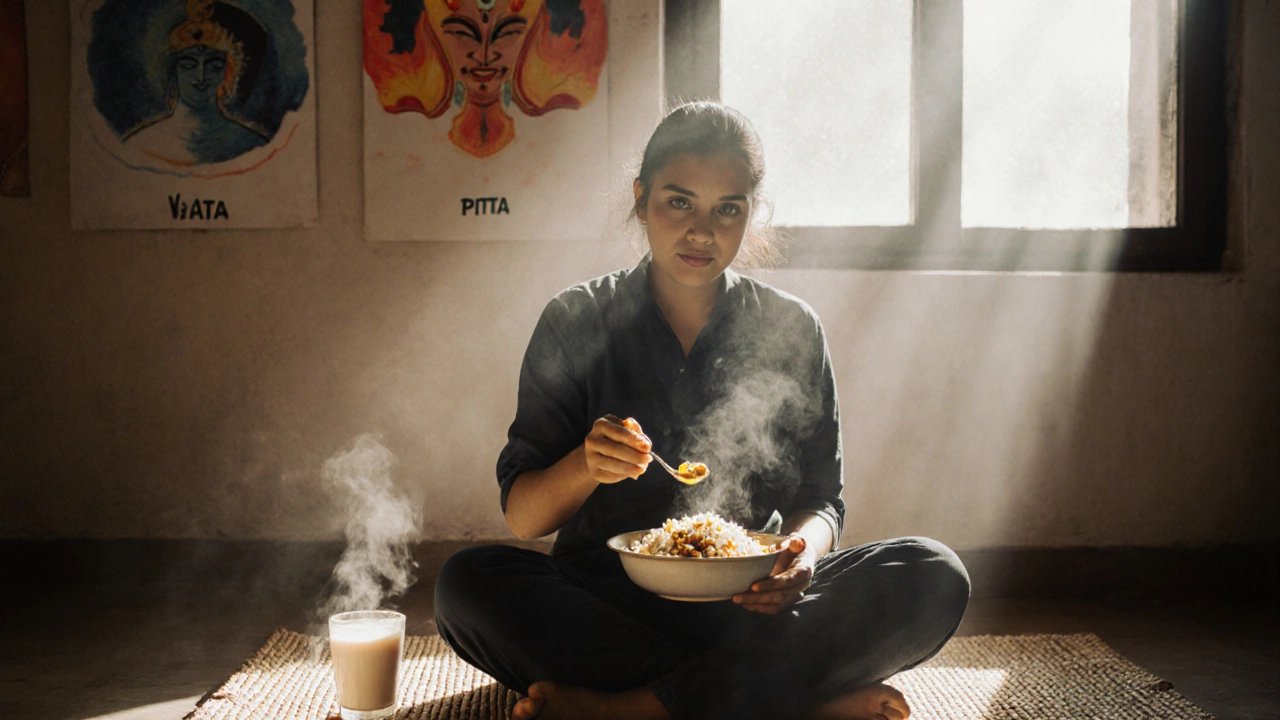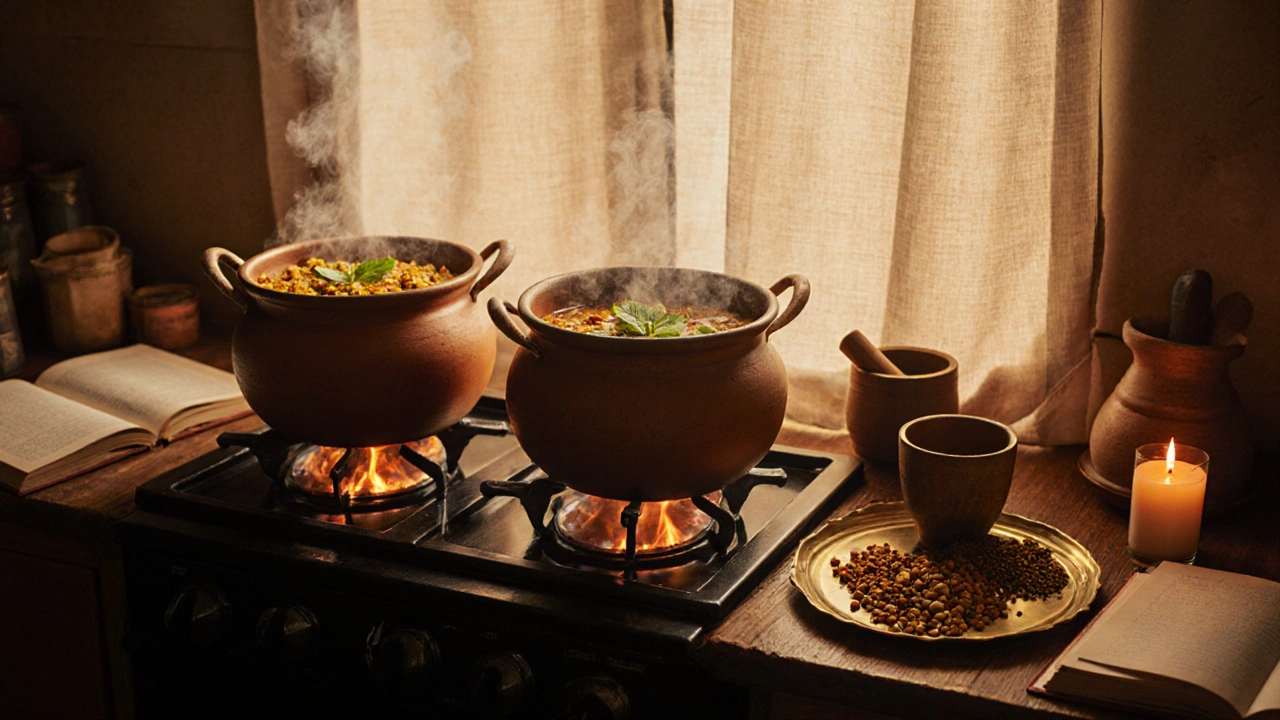Most diets tell you what to cut out-sugar, carbs, fats. The Ayurvedic diet doesn’t work that way. Instead, it asks: What kind of body do you have? It’s not about calories or portion sizes. It’s about matching your food to your natural rhythm, climate, and digestion. In India, where Ayurveda has been practiced for over 5,000 years, people don’t follow a one-size-fits-all meal plan. They eat based on their dosha-Vata, Pitta, or Kapha. These aren’t just buzzwords. They’re biological patterns that shape how you digest food, handle stress, and even sleep.
What are the three doshas?
Think of doshas as your body’s operating system. Each one is made of two of the five elements: space, air, fire, water, and earth.
- Vata is air + space. People with dominant Vata tend to be thin, energetic, and creative. But they also get cold easily, have irregular hunger, and may feel anxious or scattered.
- Pitta is fire + water. Pitta types usually have a strong metabolism, sharp focus, and a medium build. They can be intense, driven, and prone to anger or acidity if things get out of balance.
- Kapha is water + earth. Kapha individuals are often sturdy, calm, and grounded. But they may struggle with sluggish digestion, weight gain, or feeling stuck emotionally.
Most people are a mix, but one dosha usually stands out. You can’t change your dosha-it’s your genetic blueprint. But you can eat to keep it balanced.
How the Ayurvedic diet works
The Ayurvedic diet doesn’t label foods as ‘good’ or ‘bad.’ It labels them by how they affect your body. For example:
- A spicy curry might help a slow Kapha digest better-but make a Pitta person break out in heartburn.
- Cold smoothies might calm a Pitta summer day-but send a Vata person into shivers and bloating.
It’s all about energetic qualities, not nutrients. Foods are seen as warm or cool, light or heavy, dry or oily. Your job is to pick foods that balance what’s already too much in your system.
Let’s say you’re a Vata type who’s been feeling dry skin, constipation, and insomnia. You’re likely too much air and space. You need warmth, moisture, and routine. That means warm, cooked meals-like lentil stew with ghee, rice with cinnamon, and sweet fruits like bananas and mangoes. Avoid raw salads, cold drinks, and popcorn. Even tea should be warm, not iced.
Now, if you’re Pitta and you’ve been irritable, with acid reflux and red rashes, you’ve got too much fire. Cool, sweet, and bitter foods help. Think coconut water, cucumber, mint, barley, and steamed greens. Skip hot spices, coffee, and sour foods like vinegar or tomatoes.
And if you’re Kapha and you’re feeling heavy, slow, or stuck, you need light, dry, and spicy foods. Think black pepper, ginger tea, steamed vegetables, and legumes. Avoid dairy, fried foods, and sweets-even fruit juices.
When and how you eat matters more than what you eat
In Ayurveda, timing is everything. Your digestive fire-called agni-is strongest between 10 a.m. and 2 p.m. That’s why lunch is your biggest meal. Breakfast should be light. Dinner should be the smallest, eaten at least three hours before bed.
Here’s what else matters:
- Eat in a calm space. No scrolling, no TV. Stress shuts down digestion.
- Chew slowly. Ayurveda says you should chew each bite 20-30 times. It’s not about being polite-it helps your body break down food before it hits your stomach.
- Drink warm water throughout the day. Cold water douses your digestive fire.
- Don’t eat when you’re emotionally upset. Grief, anger, or anxiety disrupts your dosha balance.
Many people think Ayurveda means eating only vegetarian food. That’s not true. Some Kapha types benefit from lean meat or fish. Some Vata types need bone broth for nourishment. But most traditional Ayurvedic diets are plant-based because they’re easier to digest and less heating.

Common Ayurvedic foods and spices
You don’t need fancy superfoods. The kitchen staples in most Indian homes are already Ayurvedic:
- Ghee (clarified butter): Lubricates the system, supports brain health, and is easier to digest than regular butter.
- Turmeric: Anti-inflammatory, used in everything from milk to rice.
- Cumin, coriander, fennel: These three are often roasted and ground together as tridoshic spice mix-good for all doshas.
- Adaptogens: Ashwagandha, shatavari, and brahmi are herbs used to calm the nervous system and balance hormones.
- Warm spiced milk: Milk with a pinch of cardamom and turmeric, drunk before bed, helps Vata and Pitta sleep better.
These aren’t supplements. They’re everyday kitchen ingredients. In South India, you’ll find families roasting spices for each meal, not just for flavor-but to support digestion.
What the Ayurvedic diet is not
It’s not a weight-loss diet, though many lose weight on it. It’s not a detox plan, even though people feel lighter after switching. And it’s not about perfection.
You won’t find Ayurvedic dietitians telling you to eliminate gluten or dairy forever. Instead, they’ll ask: Do you digest dairy well? Do you feel bloated after cheese? If yes, reduce it. If no, keep it. Ayurveda doesn’t ban-it adjusts.
It’s also not a religion. You don’t need to chant or follow rituals. You just need to pay attention to how your body feels after eating.

How to start the Ayurvedic diet today
You don’t need to overhaul your whole life. Start small:
- Write down how you feel after meals for three days. Are you tired? Bloated? Energized? Irritable?
- Notice your body type. Are you thin and jittery? (Vata) Do you get hot easily? (Pitta) Do you gain weight easily? (Kapha)
- Swap one cold drink for warm water with lemon in the morning.
- Eat your biggest meal at noon, not dinner.
- Add one Ayurvedic spice to your cooking-like cumin or turmeric.
After a week, you’ll start noticing patterns. Maybe you feel better after eating warm oatmeal instead of cold cereal. Or maybe you sleep better when you skip late-night snacks.
Ayurveda doesn’t promise quick fixes. It promises awareness. And over time, that awareness turns into balance.
Who should avoid the Ayurvedic diet?
It’s safe for most people. But if you have:
- Diabetes and are on insulin
- Chronic kidney disease
- Are pregnant or breastfeeding
- Are on medications that interact with herbs (like blood thinners or thyroid meds)
Then talk to your doctor before making big changes. Some Ayurvedic herbs can interfere with prescription drugs. And while the diet itself is gentle, herbal supplements aren’t always safe without guidance.
Also, don’t try to force yourself into a dosha. Many people think they’re Pitta because they’re intense-but they’re actually Vata with stress-induced heat. Getting your dosha right matters. You can take a free online quiz, but the best way is to observe yourself over time-or see an Ayurvedic practitioner in person.
In Bangalore, where I live, you’ll find clinics where doctors ask not just about your symptoms, but your sleep, your bowel movements, your emotional patterns. That’s Ayurveda. It’s not just about food. It’s about living in tune with your nature.
Can I follow the Ayurvedic diet if I’m not Indian?
Yes. The Ayurvedic diet isn’t tied to culture-it’s based on body types. People in the U.S., Europe, and Australia follow it successfully. You might need to swap Indian spices for similar ones (like using ginger instead of black pepper if you don’t like heat), but the principles stay the same: eat warm, cooked food, match your meals to your body, and avoid extremes.
Is the Ayurvedic diet vegetarian?
Most traditional Ayurvedic diets are plant-based because they’re easier to digest and less heating. But meat, fish, and eggs aren’t forbidden. A Kapha person might benefit from lean chicken or fish. A Vata person recovering from illness might need bone broth. It depends on your digestion and dosha-not religion or culture.
How long does it take to see results?
Many people feel lighter, sleep better, or have less bloating within 7-10 days. But deeper changes-like better digestion, stable energy, or reduced anxiety-take 4-6 weeks. Ayurveda works slowly because it’s rebuilding your inner rhythm, not just cutting out food.
Do I need to buy special Ayurvedic products?
No. You don’t need expensive supplements, powders, or branded teas. Start with your kitchen: turmeric, cumin, ghee, ginger, rice, lentils, and seasonal vegetables. Ayurveda is about using what’s already around you, not buying into trends.
Can I combine the Ayurvedic diet with other diets like keto or vegan?
It’s possible, but risky. Keto is high-fat and cold-bad for Vata and Kapha. Vegan diets are often raw and light-bad for Vata. If you want to blend them, you need to adapt. For example, a vegan Kapha person could eat cooked lentils, steamed veggies, and spicy soups instead of raw salads. The key is flexibility, not rigidity.
Next steps: Start observing, not restricting
The Ayurvedic diet isn’t about rules. It’s about noticing. Keep a simple journal: what you ate, how you felt 2 hours later, your energy level, your mood. After a week, you’ll see patterns. Maybe you feel sluggish after dairy. Maybe you sleep better with warm milk. That’s your body talking.
You don’t need to become an expert. Just start eating with awareness. That’s the real power of Ayurveda-not what you eat, but how you pay attention to it.

 How Long Is the Average Stay in Rehab After Knee Replacement?
How Long Is the Average Stay in Rehab After Knee Replacement?
 Top High-Risk Heart Surgeries: Understanding the Dangers
Top High-Risk Heart Surgeries: Understanding the Dangers
 Can You Kneel After Knee Replacement? What Really Happens and When You Can Expect to Kneel Again
Can You Kneel After Knee Replacement? What Really Happens and When You Can Expect to Kneel Again
 What Is the Most Common Orthopedic Emergency? A Deep Dive into Fractures
What Is the Most Common Orthopedic Emergency? A Deep Dive into Fractures
 Can an Orthopedic Doctor Fix a Pinched Nerve?
Can an Orthopedic Doctor Fix a Pinched Nerve?